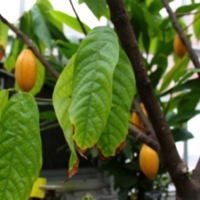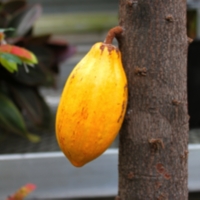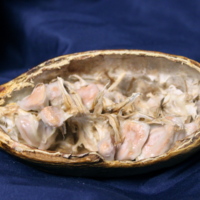Cacao Tree : Natural History
The Theobroma cacao, part of the Malvaceae family, is known commonly as the Cacao tree. It is primarily known as the tree that brings the world its chocolaty delights, but not many people know much about the tree behind the yummy chocolate. This section will detail the cacao tree: where it is from, how it grows, and many other lesser-known facts about the tree.
The cacao tree originated in the lowland rainforests of the Amazon and Orinoco river basins in South America. The Cacao tree naturally occured in clumps along the riverbanks in the Amazon basin on the eastern equatorial slopes of the Andes, but after it became commercialized, humans manipulated the tree’s habitat. Cacao trees now can be seen growing in the American tropics, Central America, Western Africa and Tropical Asia. Cacao trees in the wild grow as understory trees in the rainforest. The trees grow best with minimal fluctuations in atmospheric moisture and protection from strong winds. Often cacao will grow in riparian forests that encompass moving floodwaters of rivers for several months a year.
Like many other trees, the life cycle of the cacao starts with a seed. Cacao seeds are non-resting which means they cannot be stored. In good soils the taproot will grow deep straight into the ground, but still cacao roots are very shallow and can be damaged easily.
After about 4 years of growth, the cacao tree will mature and start-producing fruit. The tree will grow to be 8-10m tall in an ideal environment, but without shade, the tree tends to be smaller. Some leaves of the cacao start out red in color, but eventually the chlorophyll pigments dominate over the other pigments and they turn green. Mature cacao leaves are thick, smooth, bright green, leathery, and measure up to 30cm (12in) long (seen in image 2). On average, these trees produce new leaves and drop old ones two to four times a year, but healthy trees will produce new leaves with only a small number of old lost leaves.
Flowers of Cacao trees can range from being foul smelling to being odorless and they can be white, pink, rosy, yellow, or red in color. Their flowers can be present at any time of the year, but twice a year, they appear in abundance. A cacao tree can produce upwards of 10,000 flowers a year. Cacao flowers grow from “flower cushions” found on the trunk or limbs of the tree. The flowers are about 1cm (0.4in) in length and width and will die within 24 hours if not pollinated. Flower pollination usually happens in the morning. Although hermaphroditic, the cacao cannot self-pollinate, a characteristic that maintains the heakth od Cacao plants.
When flowers are pollinated, mostly by midges and sometimes bats, they produce elongated pods called cherelles. As seen in the images 3 and 4 pods can grow out of the trunk or branches of the tree. A single tree can yield up to 70 pods annually. While maturing, the pods are green, and the mature pods range in color from bright yellow to deep purple. Cherelles can grow to a length of 35cm (14in) and width of 12cm (4.7in). The pods are divided into 10 sections by ridges that run lengthwise and they will contain anywhere from 20 to 60 seeds (cocoa beans). The cocoa beans are arranged along the axis of the pod and they are all covered in a sweet and sticky white colored pulp. The seeds axis and pulp can all be seen in image 5. Overall, it takes up to six months for the pods to ripen.

Image 2)
The Cacao Tree leaves located at the UVM Main Campus Greenhouse Complex. Zevin, Rachel A. (2013)

Image 3)
The Cacao Tree Pod located at the UVM Main Campus Greenhouse Complex. Zevin, Rachel A. (2013)


